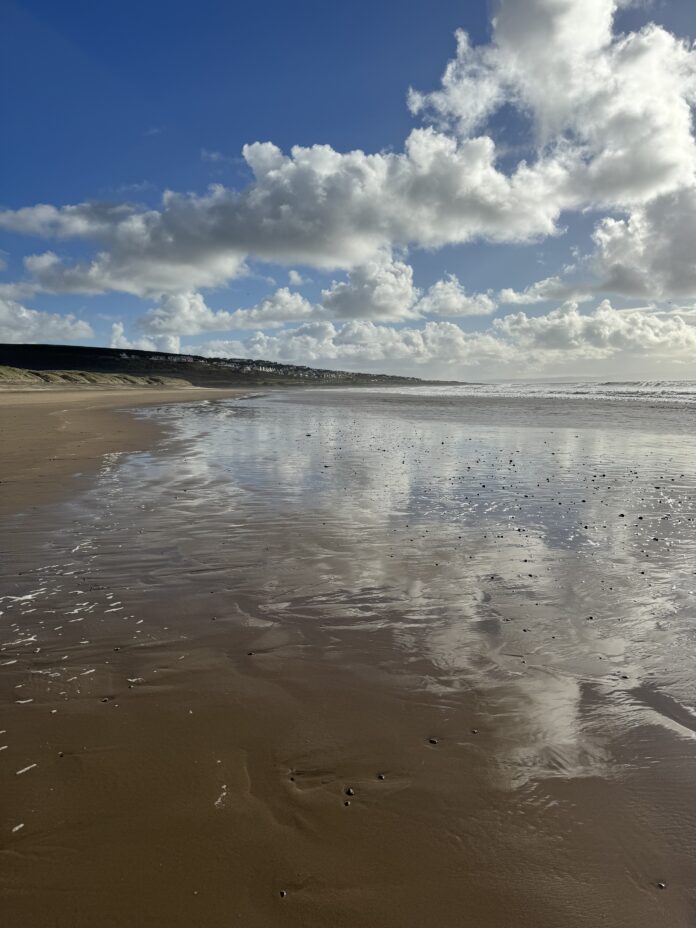When 4-year-old Lily Wilder spotted an unusual-looking rock on a Welsh beach in January 2021, she had no idea she was about to make one of the most significant paleontological discoveries in recent UK history. The boulder she found contained one of the best-preserved dinosaur footprints ever discovered in Britain, a 220-million-year-old reminder that Wales was once home to creatures that would inspire legends of dragons for centuries to come.
Wales may be known for its castles, mountains, and rugged coastline today, but venture to certain beaches along the South Wales coast and you’ll find yourself literally walking in the footsteps of dinosaurs that roamed here during the Late Triassic period, when Wales looked nothing like it does now.
A Desert Unlike Any Other
It’s hard to imagine when looking at Wales’ green valleys and rain-swept hills, but 220 million years ago, South Wales was a scorching hot desert. The region was part of the massive supercontinent Pangaea, with no Atlantic Ocean separating it from America and no North Sea dividing it from Europe. The climate was extreme, with baking heat during the day and occasional violent storms that sent flash floods tumbling down from surrounding hills.
These floods created shallow lakes and streams that quickly evaporated in the intense heat, leaving behind wet mud. As dinosaurs walked through this mud, they left impressions that baked hard in the sun before being covered by the next flood. Over millions of years, these footprints were preserved in what geologists call the Mercia Mudstone, the distinctive reddish rock that now dots the South Wales coastline.
The Main Sites: Where to Find Dinosaur Footprints in Wales
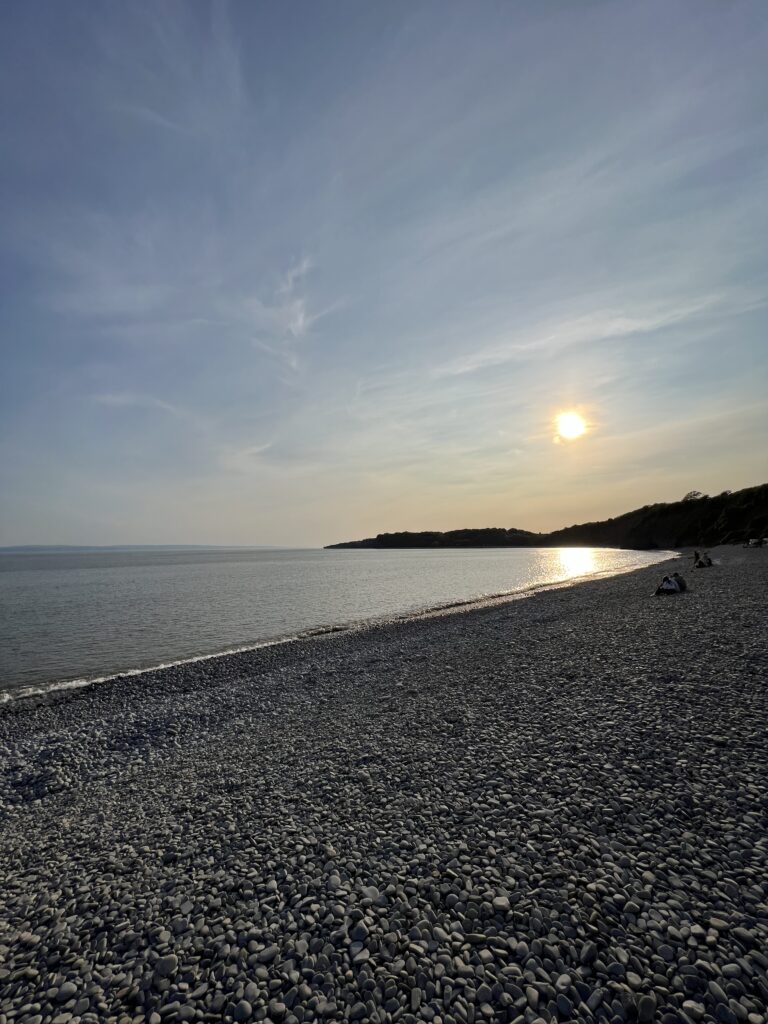
Bendricks Bay (The Bendricks), Barry
The crown jewel of Welsh dinosaur discoveries is Bendricks Bay, located between Barry and Sully on the Vale of Glamorgan coast. This Site of Special Scientific Interest (SSSI) is the richest dinosaur track locality in Wales and one of the UK’s most important coastal geological sites.
The beach exposes 220-million-year-old Triassic red beds where footprints occur over wide areas, with many individual trackways visible on single bedding planes. The first footprints here were discovered in 1974 when a cliff-top area revealed over 150 small, three-toed footprints of bipedal dinosaurs, plus several larger ones.
This is where young Lily Wilder made her famous discovery. Walking along the rocky beach with her father Richard, she spotted what she initially thought was just an interesting boulder. Upon closer inspection, the family realized it contained an exceptionally well-preserved footprint. After being verified by Cindy Howells, Palaeontology Curator at the National Museum Wales, the specimen was carefully extracted and is now on display at the National Museum Cardiff in an exhibition called “Lily’s Fossil Footprint.”
Cindy Howells described it as one of the best-preserved examples from anywhere in the UK, noting that it would really help paleontologists understand how these early dinosaurs walked. The footprint is classified as Grallator type, though it’s impossible to identify exactly which dinosaur species made it.
How to Visit: Access Bendricks Bay via a path following the security fence around HMS Cambria at Hayes Point, Sully, or via the coastal path from Barry. Visit at low tide and look carefully in the flat rock ledges. Footprints are easiest to spot when the sun is low in the sky or after rain when the small hollows fill with water.
Important Note: This is a protected SSSI. Collection of rocks, minerals, or fossils is strictly prohibited and can result in fines of up to £20,000. After Lily’s discovery made headlines, Natural Resources Wales reported incidents of people attempting to remove rocks with sledgehammers and crowbars, causing significant damage to the site. Please look but don’t touch.
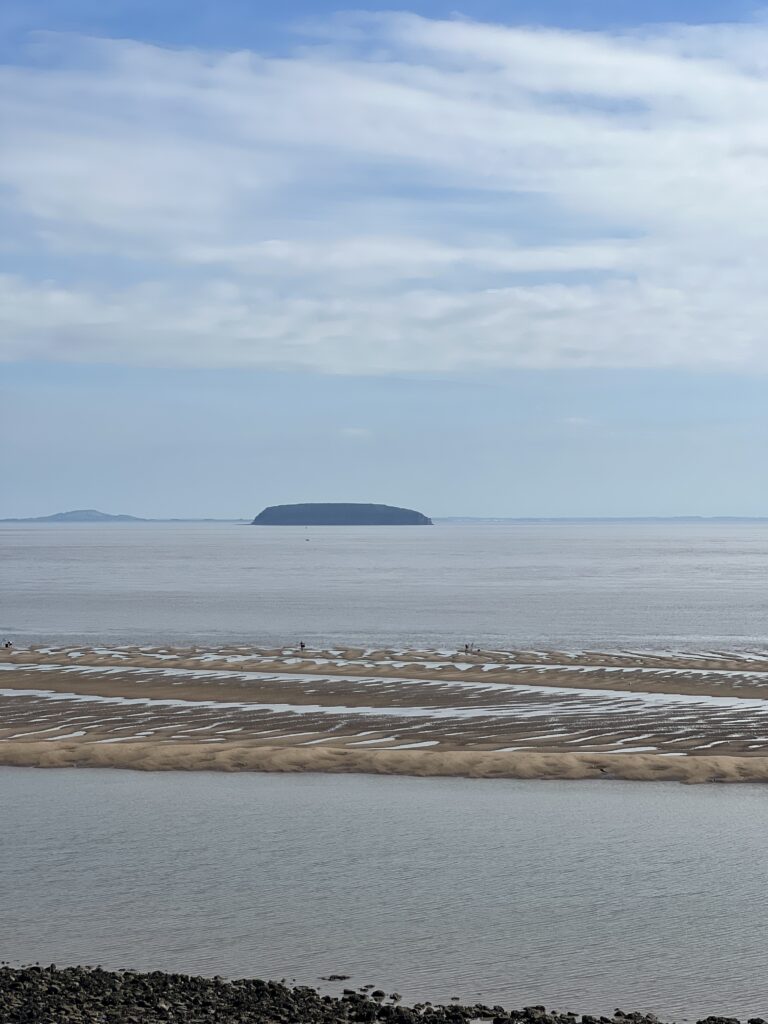
Penarth and Lavernock Point
Just a short distance from Cardiff, the beaches at Penarth and Lavernock Point have yielded remarkable dinosaur discoveries in recent years. In 2020, members of the public discovered footprints belonging to early sauropods or sauropod relatives on the shoreline near Penarth.
These footprints date from the Late Triassic epoch, over 200 million years ago, and are part of the Blue Anchor Formation. The tracks cover an exposed surface about 50 meters long and 2 meters wide, with impressions deeply embedded in the rock. Paleontologists from London’s Natural History Museum studied the tracks and identified them as examples of the ichnogenus Eosauropus, thought to have been made by sauropodomorph dinosaurs.
The footprints measure approximately 1.6 feet long, and the sheer volume of prints indicates this area was a “trampling ground” where herds of dinosaurs regularly passed through. Professor Paul Barrett from the Natural History Museum noted that researchers observed consistently spaced impressions suggesting walking animals, along with displacement rims where mud had been pushed up—characteristic structures of active movement through soft ground.
Perhaps even more exciting, in 2014, two brothers discovered a partial skeleton of a meat-eating dinosaur at Lavernock Point. Named Dracoraptor hanigani (meaning “dragon thief”), this small but significant dinosaur lived around 201 million years ago at the very start of the Jurassic Period. The fossil represents approximately 40% of a complete skeleton and is the oldest known Jurassic dinosaur, making it the first dinosaur skeleton from the Jurassic of Wales. It’s now on display at the National Museum Wales in Cardiff.
More recently, in 2025, a 10-year-old girl named Tegan discovered five massive footprints near the Vale of Glamorgan on the South Wales coast. Each footprint was spaced about 30 inches apart in a consistent pattern, suggesting they were left by a camelotia dinosaur, a lesser-known herbivore from the Late Triassic period. This distinctive dinosaur with its long neck, large body, and small head probably stood about 10 feet tall and measured 16 feet long.
Other Notable Sites
Footprints have also been discovered at various locations between Sully Island and Barry, and fossil remains have been found in other unexpected places. In the 1950s, two small fossilized dinosaurs were discovered in a quarry near Cowbridge. Both were juveniles standing about 50cm tall—one is a sauropodomorph called Pantydraco and the other a small theropod called Pendraig.
Types of Footprints Found in Wales
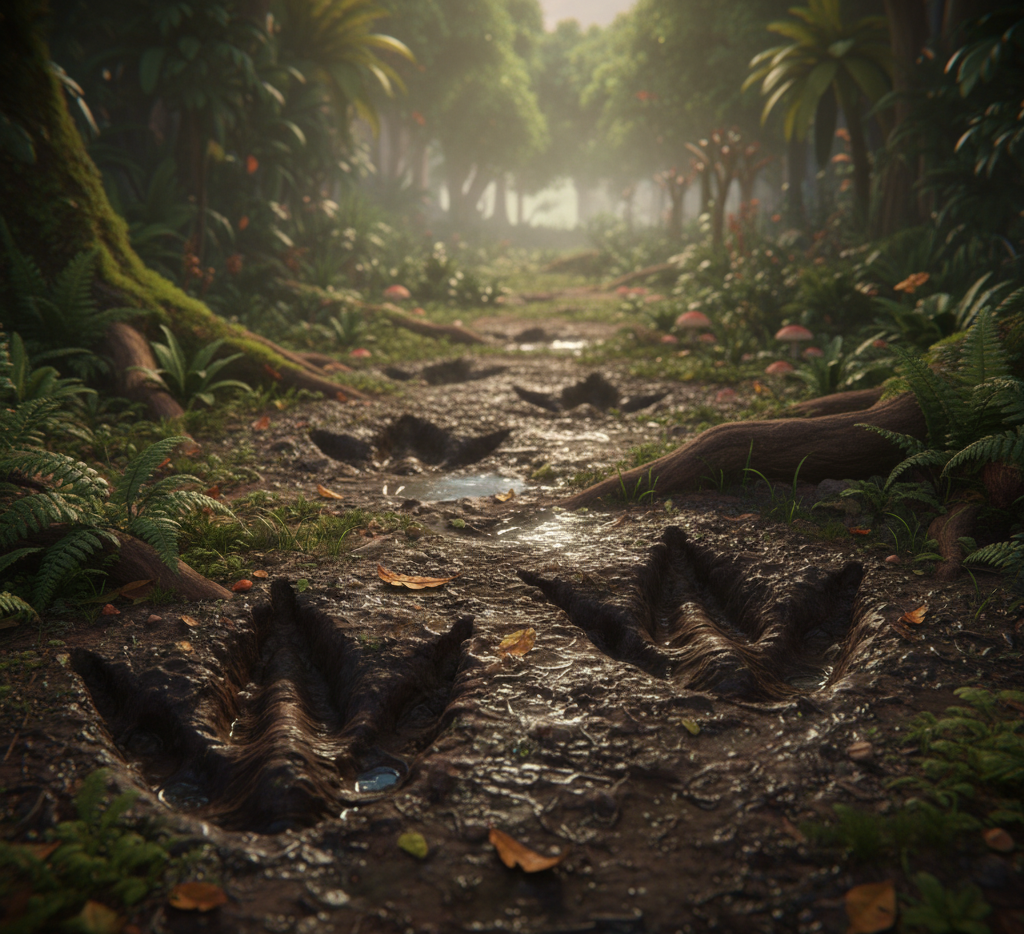
Welsh paleontologists have identified at least four different types of dinosaur footprints in South Wales, representing various sizes and species:
Grallator
These are three-toed footprints about 20cm in length with a distinctive long middle toe. Made by small, bipedal theropod dinosaurs (meat-eaters standing about 1 meter tall), similar to Coelophysis. These are the most commonly found prints at Bendricks Bay and often show clear claw marks and toe texture.
Anchisauripus
Another type of three-toed footprint from small theropods. The first evidence of dinosaurs in Wales was found in 1879 when Welsh artist and natural historian T.H. Thomas discovered this type of print near Porthcawl in the Vale of Glamorgan.
Tetrasauripus
These larger four-toed footprints were made by plant-eating dinosaurs called prosauropods, similar to Plateosaurus. These creatures were fairly large, measuring 7-8 meters long, and were capable of walking on their hind legs despite having sturdy front legs.
Eosauropus
Footprints of large sauropodomorph dinosaurs, discovered more recently at Penarth. These belong to the early relatives of the massive long-necked sauropods that would dominate later periods.
Paleontologists use these names to represent the size and shape of footprints without trying to match them to specific species, as many dinosaur types have similar feet. It’s nearly impossible to say exactly which dinosaur made any particular footprint.
What Wales Looked Like 220 Million Years Ago
The dinosaurs that left these footprints lived during the Norian Stage of the Upper Triassic period. Wales was a vastly different place:
The Landscape: Hot, arid deserts covered much of South Wales, interrupted by occasional shallow lakes and ephemeral river systems. Flash floods would periodically fill these lakes and burst across the desert floor, creating extensive mudflats.
The Climate: Extremely hot and dry, with temperatures far higher than today. Wales was located at a lower latitude, closer to the equator, as part of the Pangaea supercontinent.
The Ecosystem: A mix of primitive dinosaurs, crocodile-like reptiles, and other reptiles inhabited the region. Many of the footprints found at Bendricks Bay were actually made by crocodilian-type reptiles rather than dinosaurs.
Marine Life: Nearby shallow seas contained ichthyosaurs, plesiosaurs, and placodonts, while dinosaurs roamed the tropical lowlands beside these waters.
The Evolution to Jurassic Wales
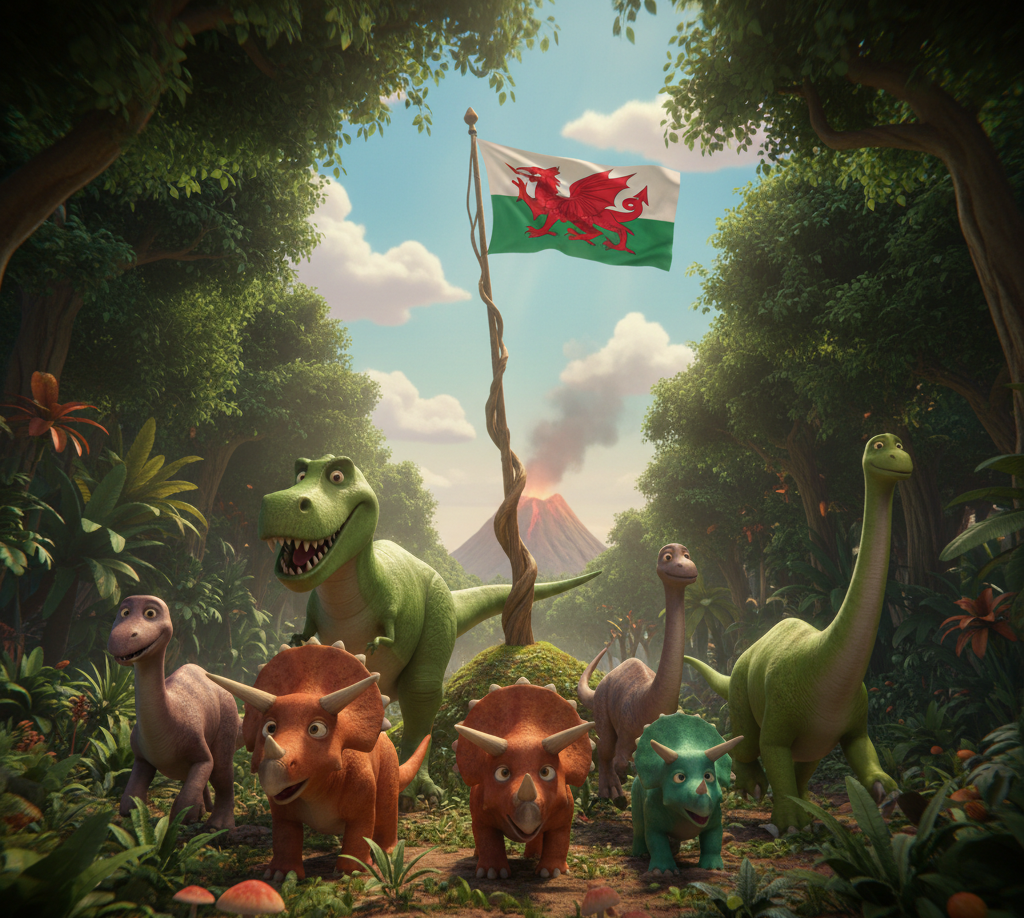
By the start of the Jurassic Period (around 201 million years ago), dramatic changes were occurring. The supercontinent Pangaea began breaking apart, the Atlantic Ocean started forming, and the Triassic deserts were slowly flooded by rising seas. The climate became much wetter, and South Wales transformed into warm, shallow seas dotted with islands that were home to early mammals, dinosaurs, and other reptiles.
This transitional period is captured beautifully at Lavernock Point, where Dracoraptor lived at the dawn of the Jurassic. This small, swift predator with sharply jagged teeth would have hunted on the remaining islands while marine reptiles dominated the surrounding seas.
Other Dinosaur Evidence in Wales
Beyond footprints, Wales has yielded other fascinating dinosaur discoveries:
Zanclodon: A jawbone found in late Triassic rock called the Quarella Sandstone shows clear impressions of several curved, backwards-pointing teeth, indicating a meat-eater. The name means “hollow-tooth,” and it’s thought to be the same general type of dinosaur that left Anchisauripus footprints.
Bone Fragments: A finger bone and toe bone of similarly sized dinosaurs have been found in the Triassic Rhaetic bone bed at Penarth, though these remain in private ownership.
Lavernock Bone Bed: Recent discoveries at this site have revealed a complex ecosystem including the remains of large Plateosaurus-like animals and predatory theropods, along with rare coelacanth and placodont fossils.
Tips for Fossil Hunting in South Wales
If you’re inspired to search for fossils along the Welsh coast, here are some important guidelines:
Best Locations: Bendricks Bay, Penarth, and Lavernock Point are the prime sites. The coastline between Cardiff and Barry exposes excellent Triassic and early Jurassic rocks.
Timing: Visit at low tide when more rock surfaces are exposed. Check tide times before your visit.
Lighting: Footprints are easiest to spot in low sunlight (early morning or late afternoon) or after rain when depressions fill with water.
What to Look For: Three-toed impressions, consistent spacing between prints, and displacement rims around footprints. Also watch for fossilized shells, ammonites, and bone fragments.
Legal Requirements: Many of these sites are protected SSSIs. You can look and photograph, but you cannot remove, damage, or destroy rocks, minerals, or fossils without permission. Violations can result in fines up to £20,000.
If You Find Something: Contact the National Museum Wales, Natural Resources Wales, or the British Institute for Geological Conservation. They can assess your find and, if significant, arrange for proper extraction and preservation.
Safety: Be aware of tide times—these areas can become cut off. Watch for cliff falls, especially after heavy rain. Wear sturdy footwear as the rocks can be slippery.
Equipment: A camera is more useful than a hammer. Good walking boots, a magnifying glass, and a guidebook to British fossils can enhance your experience.
The National Museum Cardiff: See Wales’ Dinosaurs
If you can’t make it to the beaches, or if the weather isn’t cooperating, the National Museum Cardiff houses Wales’ most significant dinosaur discoveries. The Evolution of Wales gallery features dinosaur fossils and excellent information about Wales’ prehistoric past.
Highlights include:
- Lily Wilder’s famous Grallator footprint
- The Dracoraptor hanigani skeleton from Lavernock Point
- Various footprint specimens from Bendricks Bay
- Interpretive displays explaining what Wales looked like in the Triassic and Jurassic periods
The museum also regularly hosts events and workshops about paleontology, making it an excellent family destination.
Why Welsh Dinosaurs Matter
Wales’ dinosaur footprints and fossils are more than just interesting finds—they represent crucial evidence from a pivotal period in dinosaur evolution. The Late Triassic was when dinosaurs were first diversifying into the groups that would dominate the planet for the next 150 million years. These early dinosaurs, barely 10 million years removed from their crocodile-like ancestors, were just beginning their evolutionary journey.
The richness of Welsh fossil sites has transformed our understanding of UK paleontology. Cindy Howells notes that until recently, Wales had so few dinosaur finds that researchers didn’t think there were many dinosaurs here. Now, with a footprint or bone find every five to six years, scientists know Wales had a continuous sequence of dinosaurs living here over at least 15 million years.
These discoveries also help paint a picture of ancient ecosystems, showing how dinosaurs interacted with their environment and each other. The trampling grounds at Penarth suggest herds moving together, while the diverse footprint types at Bendricks Bay indicate a rich community of different dinosaur species sharing the same habitat.
The Future of Discovery
The South Wales coast continues to yield new discoveries as erosion exposes fresh rock surfaces and eagle-eyed visitors spot unusual features. Climate change and coastal erosion mean that new fossils are constantly being revealed, but they’re also at risk of being lost to the sea before they can be studied.
That’s why discoveries like Lily’s and Tegan’s are so important. By reporting finds to proper authorities, members of the public ensure that these precious windows into the past are preserved for future generations and can contribute to scientific understanding.
Who knows what the next big storm or particularly low tide might reveal? Perhaps the next major dinosaur discovery in Wales will be made by you.
Planning Your Dinosaur Adventure
If you’re planning to explore Wales’ dinosaur heritage, here’s a suggested itinerary:
Day 1: Cardiff and Penarth
- Morning: National Museum Cardiff to see the dinosaur collection
- Afternoon: Walk the coastal path to Penarth and Lavernock Point at low tide
- Evening: Explore historic Penarth, including the Victorian pier
Day 2: Barry and Bendricks Bay
- Morning: Visit Barry Island and the Welsh seaside heritage
- Low tide: Walk to Bendricks Bay to view footprints in situ
- Afternoon: Explore Barry Docks heritage and the area’s industrial history
Accommodation: Both Cardiff and Barry offer excellent accommodation options, from budget-friendly B&Bs to luxury hotels.
Travel: The area is easily accessible by car or train. Cardiff is a major rail hub, and Barry has direct train connections. The Wales Coast Path connects all these locations for keen walkers.
Other Useful Articles
Barry, Wales: The Little Seaside Town That Captures Big Hearts
Fall in Love with Penarth: Elegant Seaside Escape from Cardiff
Autumn Walks: A Fairytale Forest Trail Near Cardiff
Why Cardiff Bay is a must visit destination
A Legacy Written in Stone
The dinosaur footprints scattered along Wales’ South Coast are humbling reminders of deep time. The vast stretches of geological history that dwarf human existence. When you stand on Bendricks Bay at low tide, looking at a three-toed impression in the rock, you’re seeing direct evidence of a living creature that walked that exact spot 220 million years ago, when Wales was a desert and dinosaurs were just beginning their reign.
These footprints connect us to a Wales that existed long before mountains were shaped, before the first forests grew, before the first mammals scurried across the landscape. They remind us that our green and pleasant land has a history far older and stranger than castles and kings. There is a history written not in books or chronicles, but in the rocks beneath our feet.
So the next time you walk a Welsh beach, look carefully at the rocks around you. That unusual impression might not be just a trick of erosion. It could be a window into the age of dinosaurs, waiting 220 million years for someone with sharp eyes to notice. After all, if a 4-year-old could find one of Britain’s best-preserved dinosaur footprints, so could you.
Practical Information
Best Time to Visit: Spring through autumn for better weather, but fossils can be spotted year-round. Always check tide times.
Accessibility: Beach access varies; Bendricks Bay requires walking across uneven terrain. Penarth has easier access with coastal paths.
Family-Friendly: These sites are excellent for children, though supervision is essential near water and cliffs.
Facilities: Barry and Penarth have cafes, restaurants, and toilets. Bring snacks and water if planning extended beach time.
Note: This article provides general information about dinosaur footprints and fossil sites in Wales. Always respect site protections, check tide times, and prioritise safety when visiting coastal locations. If you discover what you believe to be a significant fossil, contact the National Museum Wales before attempting to remove it.

